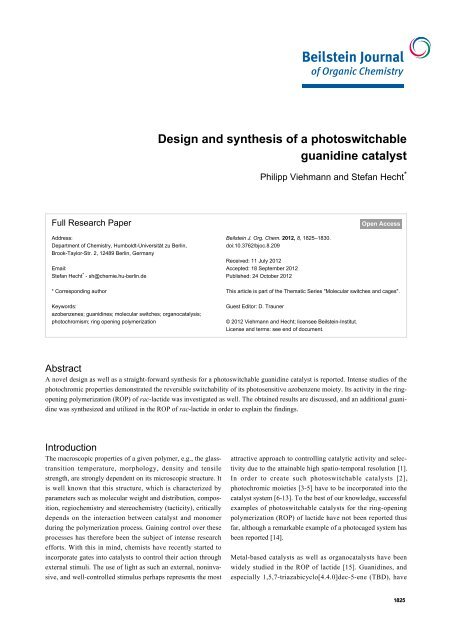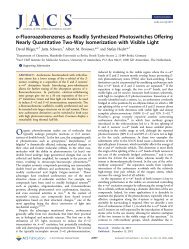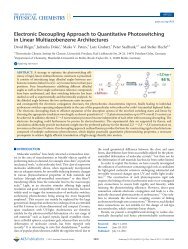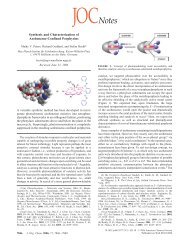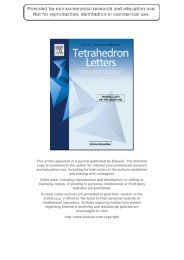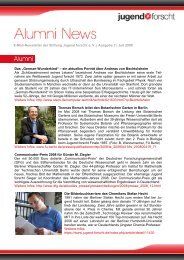Design and synthesis of a photoswitchable guanidine ... - HechtLab
Design and synthesis of a photoswitchable guanidine ... - HechtLab
Design and synthesis of a photoswitchable guanidine ... - HechtLab
You also want an ePaper? Increase the reach of your titles
YUMPU automatically turns print PDFs into web optimized ePapers that Google loves.
<strong>Design</strong> <strong>and</strong> <strong>synthesis</strong> <strong>of</strong> a <strong>photoswitchable</strong><br />
<strong>guanidine</strong> catalyst<br />
Philipp Viehmann <strong>and</strong> Stefan Hecht *<br />
Full Research Paper<br />
Open Access<br />
Address:<br />
Department <strong>of</strong> Chemistry, Humboldt-Universität zu Berlin,<br />
Brook-Taylor-Str. 2, 12489 Berlin, Germany<br />
Email:<br />
Stefan Hecht * - sh@chemie.hu-berlin.de<br />
* Corresponding author<br />
Keywords:<br />
azobenzenes; <strong>guanidine</strong>s; molecular switches; organocatalysis;<br />
photochromism; ring opening polymerization<br />
Beilstein J. Org. Chem. 2012, 8, 1825–1830.<br />
doi:10.3762/bjoc.8.209<br />
Received: 11 July 2012<br />
Accepted: 18 September 2012<br />
Published: 24 October 2012<br />
This article is part <strong>of</strong> the Thematic Series "Molecular switches <strong>and</strong> cages".<br />
Guest Editor: D. Trauner<br />
© 2012 Viehmann <strong>and</strong> Hecht; licensee Beilstein-Institut.<br />
License <strong>and</strong> terms: see end <strong>of</strong> document.<br />
Abstract<br />
A novel design as well as a straight-forward <strong>synthesis</strong> for a <strong>photoswitchable</strong> <strong>guanidine</strong> catalyst is reported. Intense studies <strong>of</strong> the<br />
photochromic properties demonstrated the reversible switchability <strong>of</strong> its photosensitive azobenzene moiety. Its activity in the ringopening<br />
polymerization (ROP) <strong>of</strong> rac-lactide was investigated as well. The obtained results are discussed, <strong>and</strong> an additional <strong>guanidine</strong><br />
was synthesized <strong>and</strong> utilized in the ROP <strong>of</strong> rac-lactide in order to explain the findings.<br />
Introduction<br />
The macroscopic properties <strong>of</strong> a given polymer, e.g., the glasstransition<br />
temperature, morphology, density <strong>and</strong> tensile<br />
strength, are strongly dependent on its microscopic structure. It<br />
is well known that this structure, which is characterized by<br />
parameters such as molecular weight <strong>and</strong> distribution, composition,<br />
regiochemistry <strong>and</strong> stereochemistry (tacticity), critically<br />
depends on the interaction between catalyst <strong>and</strong> monomer<br />
during the polymerization process. Gaining control over these<br />
processes has therefore been the subject <strong>of</strong> intense research<br />
efforts. With this in mind, chemists have recently started to<br />
incorporate gates into catalysts to control their action through<br />
external stimuli. The use <strong>of</strong> light as such an external, noninvasive,<br />
<strong>and</strong> well-controlled stimulus perhaps represents the most<br />
attractive approach to controlling catalytic activity <strong>and</strong> selectivity<br />
due to the attainable high spatio-temporal resolution [1].<br />
In order to create such <strong>photoswitchable</strong> catalysts [2],<br />
photochromic moieties [3-5] have to be incorporated into the<br />
catalyst system [6-13]. To the best <strong>of</strong> our knowledge, successful<br />
examples <strong>of</strong> <strong>photoswitchable</strong> catalysts for the ring-opening<br />
polymerization (ROP) <strong>of</strong> lactide have not been reported thus<br />
far, although a remarkable example <strong>of</strong> a photocaged system has<br />
been reported [14].<br />
Metal-based catalysts as well as organocatalysts have been<br />
widely studied in the ROP <strong>of</strong> lactide [15]. Guanidines, <strong>and</strong><br />
especially 1,5,7-triazabicyclo[4.4.0]dec-5-ene (TBD), have<br />
1825
Beilstein J. Org. Chem. 2012, 8, 1825–1830.<br />
proven to be very powerful in this context (Scheme 1) [16].<br />
However, due to the discussion <strong>of</strong> several polymerization mechanisms<br />
[17], TBD is a difficult target for the incorporation <strong>of</strong><br />
photoresponsive switches. Recent work indicates that the activation<br />
mechanism for acyclic <strong>guanidine</strong>s, such as <strong>guanidine</strong> 1<br />
(Scheme 1), is strongly dependent on the formation <strong>of</strong> hydrogen<br />
bridges to monomer <strong>and</strong> initiator [18]. Note that with pyrenebutanol<br />
as the initiator, 200 repeat units are grown within 20 s by<br />
using TBD as the catalyst, while 1 h is needed with the acyclic<br />
<strong>guanidine</strong> 1 to reach the same average chain length.<br />
Scheme 1: Ring-opening polymerization (ROP) <strong>of</strong> lactide with TBD or<br />
the acyclic <strong>guanidine</strong> 1 as catalysts [16,18].<br />
Based on this finding it should be possible to create a catalyst<br />
that may be deactivated by formation <strong>of</strong> intramolecular<br />
hydrogen bonds to an acceptor (A) <strong>and</strong> activated by light-triggered<br />
dissociation <strong>of</strong> such intramolecular hydrogen bonds<br />
(Scheme 2). Herein, we report the <strong>synthesis</strong> <strong>of</strong> the first <strong>photoswitchable</strong><br />
<strong>guanidine</strong>, as well as its photochromic behavior.<br />
Scheme 2: Illustration <strong>of</strong> a <strong>photoswitchable</strong> <strong>guanidine</strong> catalyst for the ROP <strong>of</strong> lactide <strong>and</strong> the corresponding target structures 2 Z <strong>and</strong> 2 E (S = switching<br />
unit, A = H-bond acceptor).<br />
1826
Beilstein J. Org. Chem. 2012, 8, 1825–1830.<br />
Upon irradiation, the incorporated azobenzene is supposed to<br />
undergo photoinduced E→Z isomerization, allowing the<br />
Brønsted acceptor, in this case a ketone, to form a hydrogenbridge<br />
to the proton <strong>of</strong> the <strong>guanidine</strong>.<br />
Results <strong>and</strong> Discussion<br />
The <strong>synthesis</strong> <strong>of</strong> <strong>guanidine</strong> 2 E (Scheme 3) was accomplished<br />
starting from phenylisocyanate (3) <strong>and</strong> 3-nitroaniline (6). The<br />
latter was converted by known procedures into its corresponding<br />
nitroso derivative 7 [19], followed by a Mills coupling<br />
with 4-aminoacetophenone (8) to give azobenzene 9 in 93%<br />
yield over two steps. Nitroazobenzene 9 was transformed into<br />
its amino derivative 10 by catalytic hydrogenation. Note that<br />
under the employed conditions reduction <strong>of</strong> the azobenzene<br />
function <strong>of</strong> compound 9 was observed, yet the formed<br />
hydrazine analogue reoxidized in situ upon being stirred under<br />
atmospheric conditions (air). The free amine 10 finally reacts<br />
with the in situ prepared Vilsmeyer salt 5 to provide the<br />
desired target compound 2 E . The therefore necessary urea 4 can<br />
be obtained from the addition <strong>of</strong> pyrrolidine to phenylisocyanate<br />
(3).<br />
The structure <strong>of</strong> <strong>guanidine</strong> 2 E was proven by NMR spectroscopy,<br />
HRMS, as well as by single-crystal X-ray structure<br />
analysis (Figure 1). To our knowledge, this is the first example<br />
<strong>of</strong> an X-ray analysis <strong>of</strong> an acyclic <strong>guanidine</strong>–methanol adduct,<br />
clearly proving the existence <strong>of</strong> a hydrogen bridge between an<br />
alcohol OH function <strong>and</strong> the nitrogen <strong>of</strong> the <strong>guanidine</strong>. This<br />
significantly supports the mechanism <strong>of</strong> alcohol activation in<br />
the polymerization process. Additionally, the crystal structure<br />
confirms the validity <strong>of</strong> our concept, illustrating the azobenzene’s<br />
utilization as a spacer by spatial separation <strong>of</strong> the <strong>guanidine</strong><br />
core <strong>and</strong> carbonyl function.<br />
In order to utilize the incorporated light-sensitive azobenzene<br />
functionality, the photochromic behavior <strong>of</strong> <strong>guanidine</strong> 2 was<br />
Scheme 3: Synthesis <strong>of</strong> <strong>guanidine</strong> 2 E .<br />
1827
Beilstein J. Org. Chem. 2012, 8, 1825–1830.<br />
Figure 1: ORTEP image <strong>of</strong> the single-crystal X-ray structure <strong>of</strong> <strong>guanidine</strong> 2 E , as well as a rotated close-up <strong>of</strong> the <strong>guanidine</strong> moiety, showing 50%<br />
thermal ellipsoids (CCDC 891016).<br />
investigated by UV–vis spectroscopy (Figure 2). The UV–vis<br />
spectrum <strong>of</strong> <strong>guanidine</strong> 2 E in acetonitrile exhibits the expected<br />
behavior, similar to the unsubstituted parent azobenzene, i.e., a<br />
low intensity n→π* b<strong>and</strong> in the visible region <strong>and</strong> a much<br />
stronger π→π* b<strong>and</strong> in the UV region <strong>of</strong> the spectrum. Note<br />
that the n→π* b<strong>and</strong> partially overlaps with the π→π* b<strong>and</strong> in<br />
the (E)-isomer. Upon irradiation at 340 nm (Figure 2a), the<br />
π→π* b<strong>and</strong> <strong>of</strong> the isomer 2 E at 326 nm vanishes <strong>and</strong> the π→π*<br />
b<strong>and</strong> <strong>of</strong> the isomer 2 Z with its blue-shifted maximum at 273 nm<br />
appears. The content <strong>of</strong> isomer 2 Z in the photostationary state<br />
(pss) was determined to amount to 61% by UPLC using a detection<br />
wavelength on the isosbestic point (290 nm). Based on this<br />
Figure 2: UV–vis spectra <strong>of</strong> <strong>guanidine</strong> 2 in acetonitrile, c = 3.9·10 −5 mol/L. (a) E→Z isomerization with irradiation at 340 nm, 25 °C; (b) Z→E isomerization<br />
with irradiation at 254 nm, 25 °C; (c) thermal Z→E isomerization at 40 °C; (d) spectra <strong>of</strong> 2 E (blue) <strong>and</strong> 2 Z (calculated, red).<br />
1828
Beilstein J. Org. Chem. 2012, 8, 1825–1830.<br />
data, the UV–vis spectrum <strong>of</strong> the isomer 2 Z was calculated<br />
(Figure 2d), assuming that the total absorption is the sum <strong>of</strong> the<br />
partial absorptions. Obviously, the significant hypsochromic<br />
shift <strong>of</strong> the π→π* b<strong>and</strong> leads to a separation <strong>of</strong> the n→π* <strong>and</strong><br />
π→π* b<strong>and</strong>s for the (Z)-isomer. As expected, an inverse behavior<br />
is observed upon irradiation at 254 nm, inducing photoisomerization<br />
<strong>of</strong> <strong>guanidine</strong> 2 Z back to its precursor 2 E (Figure 2b).<br />
The amount <strong>of</strong> isomer 2 E in the resulting pss was determined to<br />
be 94%. The same nearly quantitative Z→E photoisomerization,<br />
giving 92% <strong>of</strong> 2 E in the pss, is obtained upon irradiation at 430<br />
nm.<br />
the acceptor ketone moiety itself may interact with the initiator<br />
or the active end <strong>of</strong> the polymer chain, thereby interfering with<br />
catalysis. In order to examine the latter, <strong>guanidine</strong> 11 was<br />
synthesized from Vilsmeyer salt 13 <strong>and</strong> aniline <strong>and</strong> tested in the<br />
ROP <strong>of</strong> rac-lactide (Scheme 4). The morpholino substituent<br />
was introduced to improve the crystallization behavior <strong>of</strong> <strong>guanidine</strong><br />
<strong>and</strong> should not affect the polymerization.<br />
Related to the supposed function <strong>of</strong> <strong>guanidine</strong> as a switchable<br />
catalyst, these experiments demonstrate the reversible photoisomerization<br />
<strong>of</strong> the azobenzene moiety. Nevertheless, the<br />
switching properties can still be improved, in particular to<br />
obtain a pss with higher (Z)-content in the E→Z photoisomerization.<br />
Besides the photo-induced Z→E isomerization, the<br />
thermal back-reaction <strong>of</strong> <strong>guanidine</strong> 2 Z was examined as well<br />
(Figure 2c). Based on the measured UV–vis <strong>and</strong> UPLC data <strong>and</strong><br />
assuming a first-order rate law, the rate constant <strong>of</strong> the thermal<br />
Z→E isomerization at 40 °C was determined to be k (40 °C) =<br />
6.3·10 −5 s −1 corresponding to a half-life <strong>of</strong> τ 1/2 = 3 h. The<br />
measurement at slightly elevated temperature (40 °C) was<br />
necessary since at 25 °C the thermal half-life increases significantly<br />
(Supporting Information File 1, Figure S-5), leading to<br />
distinct difficulties in its determination, e.g., the evaporation <strong>of</strong><br />
the solvent <strong>and</strong> the resulting change in concentration. Therefore,<br />
the rate constant <strong>and</strong> thermal half-life at 25 °C could only be<br />
estimated by using data points from the first 36 h (Supporting<br />
Information File 1, Figure S-6) yielding k (25 °C) = 4.2·10 −6 s −1<br />
<strong>and</strong> τ 1/2 = 46 h. Consequently, the half-life significantly exceeds<br />
the expected duration <strong>of</strong> the polymerization reaction [18],<br />
rendering <strong>guanidine</strong> 2 very attractive for this purpose. In<br />
summary, the observed photochromic behavior detailed above<br />
indicates promising properties for the utilization <strong>of</strong> <strong>guanidine</strong> 2<br />
as a <strong>photoswitchable</strong> catalyst.<br />
Scheme 4: Guanidine 11 as a catalyst in the ROP <strong>of</strong> rac-lactide (catalyst/initiator/monomer<br />
ratio = 10:1:100).<br />
In a catalyst/initiator/monomer ratio <strong>of</strong> 10:1:100 with pyrenebutanol<br />
as initiator no significant formation <strong>of</strong> polylactide was<br />
observed at rt even after 48 h. This indicates that the catalytic<br />
inactivity <strong>of</strong> <strong>guanidine</strong> 2 E is indeed caused by the <strong>guanidine</strong><br />
core itself. Besides the previously mentioned basicity issue, a<br />
possible reason for this behavior may be discerned from the<br />
single-crystal X-ray structure analysis <strong>of</strong> <strong>guanidine</strong> 2 E . It can be<br />
seen that, in contrast to the supposed polymerization mechanism<br />
(Figure 3a) [18], the lone pair <strong>of</strong> the nitrogen <strong>and</strong> the<br />
hydrogen <strong>of</strong> the adjacent nitrogen are not arranged in a parallel<br />
manner, i.e., unidirectional facing the substrates (Figure 3b). If<br />
the observed conformation is not caused by stacking effects in<br />
the solid state <strong>and</strong> prevails in solution, it may substantially<br />
lower the catalytic activity <strong>of</strong> the <strong>guanidine</strong>s 2 E <strong>and</strong> 11.<br />
In order to determine the activity <strong>of</strong> the catalyst, the crystalbound<br />
methanol was removed <strong>and</strong> <strong>guanidine</strong> 2 E was utilized in<br />
the ROP <strong>of</strong> rac-lactide with pyrenebutanol as the initiator. In a<br />
catalyst/initiator/monomer ratio <strong>of</strong> 1:1:100 no significant formation<br />
<strong>of</strong> polylactide was observed at rt even after 48 h. The<br />
absence <strong>of</strong> reactivity for <strong>guanidine</strong> 2 E in the ROP <strong>of</strong> rac-lactide<br />
may have various origins. First <strong>of</strong> all, it is obvious that in comparison<br />
with catalytically active <strong>guanidine</strong> 1, the two cyclohexane<br />
substituents on the nitrogen atoms <strong>of</strong> <strong>guanidine</strong> are<br />
replaced by aromatic residues, which, at least in one case, is<br />
necessary for connecting the photochromic azobenzene moiety<br />
to the <strong>guanidine</strong> core. This replacement most likely results in a<br />
significant reduction <strong>of</strong> the basicity <strong>of</strong> <strong>guanidine</strong>. Additionally,<br />
Figure 3: Supposed intermediates resulting from either a cyclohexanesubstituted<br />
<strong>guanidine</strong> (a) [18] or an aromatic substituted <strong>guanidine</strong> (b)<br />
with an alcohol <strong>and</strong> lactide.<br />
1829
Beilstein J. Org. Chem. 2012, 8, 1825–1830.<br />
Conclusion<br />
In summary, we developed a new approach to the design <strong>and</strong><br />
<strong>synthesis</strong> <strong>of</strong> the novel, <strong>photoswitchable</strong> <strong>guanidine</strong> 2. After<br />
detailed investigation <strong>of</strong> its photochromic properties <strong>and</strong><br />
demonstrating its reversible, light-induced switchability, we<br />
started to investigate the reasons for its inactivity in the ROP <strong>of</strong><br />
lactide. Our efforts are now directed toward the improvement <strong>of</strong><br />
the design <strong>of</strong> the catalyst by exchanging one aromatic residue<br />
with an alkyl substituent to improve the basicity <strong>of</strong> <strong>guanidine</strong>,<br />
as well as by introducing sterically crowded substituents or ring<br />
constraints in order to direct the position <strong>of</strong> the relevant lone<br />
pair <strong>of</strong> <strong>guanidine</strong> as well as the NH-function.<br />
Supporting Information<br />
The crystal structure has been deposited at the Cambridge<br />
Crystallographic Data Centre <strong>and</strong> allocated the deposition<br />
number CCDC 891016.<br />
Supporting Information File 1<br />
Experimental details <strong>and</strong> spectra.<br />
[http://www.beilstein-journals.org/bjoc/content/<br />
supplementary/1860-5397-8-209-S1.pdf]<br />
Acknowledgements<br />
We thank Stefan Mebs (HU Berlin) for carrying out the singlecrystal<br />
X-ray analysis. Generous support by the German<br />
Research Foundation (DFG via SPP 1178) <strong>and</strong> the European<br />
Science Foundation (ESF via P2M) is gratefully acknowledged.<br />
We thank BASF AG, Bayer Industry Service, <strong>and</strong> Sasol<br />
Germany for donations <strong>of</strong> chemicals.<br />
References<br />
1. Russew, M.-M.; Hecht, S. Adv. Mater. 2010, 22, 3348–3360.<br />
doi:10.1002/adma.200904102<br />
2. Stoll, R. S.; Hecht, S. Angew. Chem., Int. Ed. 2010, 49, 5054–5075.<br />
doi:10.1002/anie.201000146<br />
3. Dürr, H.; Bouas-Laurent, H., Eds. Photochromism: Molecules <strong>and</strong><br />
Systems, Revised Edition ed.; Elsevier: Amsterdam, 2003.<br />
4. Feringa, B. L., Ed. Molecular Switches, 2nd ed.; Wiley-VCH: Weinheim,<br />
Germany, 2001.<br />
5. Crano, J. C.; Guglielmetti, R. J., Eds. Organic Photochromic <strong>and</strong><br />
Thermochromic Compounds; Plenum Publishers: New York, 1999.<br />
6. Peters, M. V.; Stoll, R. S.; Kühn, A.; Hecht, S. Angew. Chem., Int. Ed.<br />
2008, 47, 5968–5972. doi:10.1002/anie.200802050<br />
7. Stoll, R. S.; Hecht, S. Org. Lett. 2009, 11, 4790–4793.<br />
doi:10.1021/ol902166a<br />
8. Stoll, R. S.; Peters, M. V.; Kuhn, A.; Heiles, S.; Goddard, R.; Bühl, M.;<br />
Thiele, C. M.; Hecht, S. J. Am. Chem. Soc. 2009, 131, 357–367.<br />
doi:10.1021/ja807694s<br />
9. Ueno, A.; Takahashi, K.; Osa, T. J. Chem. Soc., Chem. Commun.<br />
1981, 94–96. doi:10.1039/C39810000094<br />
10. Lee, W.-S.; Ueno, A. Macromol. Rapid Commun. 2001, 22, 448–450.<br />
doi:10.1002/1521-3927(20010301)22:63.0.CO;2<br />
-W<br />
11. Würthner, F.; Rebek, J., Jr. Angew. Chem., Int. Ed. Engl. 1995, 34,<br />
446–450. doi:10.1002/anie.199504461<br />
12. Würthner, F.; Rebek, J. J. Chem. Soc., Perkin Trans. 2 1995,<br />
1727–1734. doi:10.1039/P29950001727<br />
13. Cacciapaglia, R.; Di Stefano, S.; M<strong>and</strong>olini, L. J. Am. Chem. Soc.<br />
2003, 125, 2224–2227. doi:10.1021/ja029331x<br />
14. Sun, X.; Gao, J. P.; Wang, Z. Y. J. Am. Chem. Soc. 2008, 130,<br />
8130–8131. doi:10.1021/ja802816g<br />
15. Dechy-Cabaret, O.; Martin-Vaca, B.; Bourissou, D. Chem. Rev. 2004,<br />
104, 6147–6176. doi:10.1021/cr040002s<br />
16. Pratt, R. C.; Lohmeijer, B. G. G.; Long, D. A.; Waymouth, R. M.;<br />
Hedrick, J. L. J. Am. Chem. Soc. 2006, 128, 4556–4557.<br />
doi:10.1021/ja060662+<br />
17. Chuma, A.; Horn, H. W.; Swope, W. C.; Pratt, R. C.; Zhang, L.;<br />
Lohmeijer, B. G. G.; Wade, C. G.; Waymouth, R. M.; Hedrick, J. L.;<br />
Rice, J. E. J. Am. Chem. Soc. 2008, 130, 6749–6754.<br />
doi:10.1021/ja0764411<br />
18. Zhang, L.; Pratt, R. C.; Nederberg, F.; Horn, H. W.; Rice, J. E.;<br />
Waymouth, R. M.; Wade, C. G.; Hedrick, J. L. Macromolecules 2010,<br />
43, 1660–1664. doi:10.1021/ma901776x<br />
19. Priewisch, B.; Rück-Braun, K. J. Org. Chem. 2005, 70, 2350–2352.<br />
doi:10.1021/jo048544x<br />
License <strong>and</strong> Terms<br />
This is an Open Access article under the terms <strong>of</strong> the<br />
Creative Commons Attribution License<br />
(http://creativecommons.org/licenses/by/2.0), which<br />
permits unrestricted use, distribution, <strong>and</strong> reproduction in<br />
any medium, provided the original work is properly cited.<br />
The license is subject to the Beilstein Journal <strong>of</strong> Organic<br />
Chemistry terms <strong>and</strong> conditions:<br />
(http://www.beilstein-journals.org/bjoc)<br />
The definitive version <strong>of</strong> this article is the electronic one<br />
which can be found at:<br />
doi:10.3762/bjoc.8.209<br />
1830


